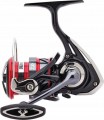Number of bearings
The number of bearings provided in the design of the reel. Bearings are used to reduce friction of rotating parts, which, on the one hand, protects such parts from wear, and on the other hand, reduces excessive effort expended when the handle is rotated. Accordingly, the
more bearings, the more friction units are protected and the better the coil is “optimized”; this parameter is a good indicator of the overall class of the product. At the same time, it is necessary to evaluate different models taking into account their purpose (see "Type").
So, in fly fishing reels, even quite expensive ones, 1 bearing is usually provided — at the point of installation of the drum on a bracket designed for attachment to the rod. This is actually the only significant friction point, so more bearings are simply not required. For multiplier reels, this number varies from 1 for relatively simple options to 6 – 7 for premium ones. And in inertia-free bearings, the number of bearings can reach a couple of dozen.
Instant anti-reverse
Instant stop of the reverse motion of the coil when unwinding. It is very important in jig fishing with stepped wiring, when you need to quickly make 2 – 3 turns and an instant stop. The function is no less in demand in feeder and carp fishing, when you need to slightly tighten the fishing line in order to put a little tension on it for a good fixation of the moment of bite, but at the same time not to move the bait from the bottom. And also an instant stop will not be superfluous when fishing on the current.
Reel material
The material from which the base of the coil is made is the part of the structure on which the spool and other mechanisms are installed.
— Plastic. Plastic is inexpensive, lightweight, corrosion resistant and completely immune to salt water. At the same time, this material is easily scratched, its strength is relatively low, and under the action of ultraviolet radiation in some grades of plastic, it is even more reduced. As a result, plastic is used mainly in entry-level coils that are not designed for difficult conditions and high loads. Usually, its quality directly depends on the price of the product.
— Graphite. Most often, this term refers to a relatively simple type of carbon fiber, which has a low cost and can be used even in low-cost-class models. At the same time, with a small weight, graphite is somewhat stronger and more resistant to certain influences than plastic, and therefore is also found in more expensive products. The quality of this material may also vary depending on the price of the coil.
— Carbon. Another type of carbon fiber, higher grade than graphite. Carbon combines high strength, flexural stability and durability under stress with extremely low weight; in addition, it is completely chemically inert (does not corrode) and tolerates ultraviolet radiation, temperature extremes, etc. well. The main disadvantage of this material can be called a high price, due to which it is used mainly in premium models. Also note tha...t carbon requires quite careful handling, because. does not take a hit well.
— Composite. Composites are materials that combine several separate components that are not mixed with each other (unlike, for example, alloys). In coils, this term most often means a combination of the graphite or carbon fiber described above with fiberglass. Fiberglass, despite the name, bears little resemblance to ordinary glass — it is highly flexible and can withstand bumps and falls without any problems; therefore, the combination of this material with carbon reduces the fragility of the latter. And in the "bundle" with graphite, fiberglass slightly increases the strength of the entire structure. The composite base can be found in models of different price categories — this is due to the difference in the quality of the components used.
— Aluminium. The main advantage of aluminium alloys can be called high strength, due to which this material can be found even in "large-caliber" coils designed for strong and heavy production. However, there are simpler options — again, aluminium alloys come in different types, and their characteristics usually depend on the price. In terms of weight, this material, if it surpasses plastic, is not much, and its corrosion resistance is very good. Of the obvious shortcomings, one can only note a rather high (in general) cost.
— Magnesium. Magnesium-based alloys are premium materials. Their main feature is extremely light weight combined with high strength and reliability, which allows you to create powerful and at the same time quite light coils. On the other hand, such products are expensive, and the material itself does not tolerate contact with salt water, and in general its resistance to corrosion is relatively low (which requires the use of special coatings).

